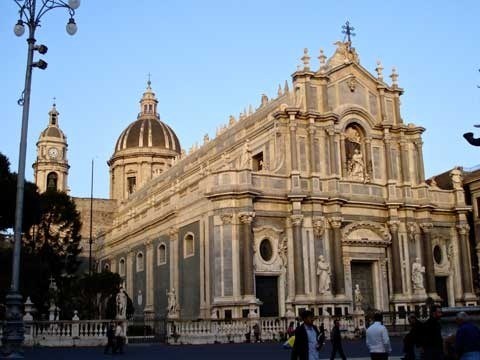We travelled by train from Palermo, south to Agrigento. The rugged, even mountainous, interior of Sicily appeared inhospitable, although it's dotted with hilltop towns and, along the slopes, olive groves or citrus farms and the occasional shepherd attending to goats.
An ancient port, Agrigento is best known for a series of Greek Doric temples that run along a ridge above the Mediterranean, a few kilometres from the city.
We took a public bus there and then explored the Valley of the Temples (Valle dei Templi), a series of Greek buildings, in various states of repair, erected circa 500 BC. The best known and most intact is the Concordia Temple, with classic tapering columns and a spectacular outlook over the Mediterranean Sea.
Then we hitchhiked up a hill to the Museo Nationale Archeologico, and reveled in the gorgeous objects found in this region, including amphora, fragments of statues and carved stone sarcophagi.
On our return at night to Palermo, an angry looking young man paced the near-empty railway carriage carrying what we thought was a gun-case. Maybe we were paranoid, but it proved unnerving.
The following afternoon, a Sunday, the Palazzo Normanni was closed. So we hopped a long-distance coach across the island to Catania - through more rugged interior, with some of the farmed valleys crossed by elevated viaduct roadways - then rolled and bumped our suitcases a few blocks to our hotel near the city centre.
The Hotel Villa Romeo came well recommended. This delightfully eccentric "palace" features idiosyncratic art on a Grecian theme, small garden courtyards off some of the rooms, classical music wafting through the halls and breakfast off an open plaza.
We shared an interior garden with a foursome of retired Australians and became friendly with hotel "manager" Romeo, who invited us to step onto a fire escape, then into an adjoining building and his sprawling old-world apartment of sumptuous antiques.
My love for baroque churches - all built after the Sicilian earthquake of 1693 - remained unquenched. I gawked at a few of the many in Catania. And we travelled south to Ragusa, whose lower town (called Ibla) is a miniature realm of ornate baroque.
My favourite spot in Sicily, Ibla is a narrow, terraced old-town of pedestrian alleys, courtyards, wrought-iron detailing and, of course, baroque churches. Several sit high above small piazzas at bends in the road that run down through the enclave. Among them San Giuseppe, with its rounded façade, and San Giorgio, standing like a testament to a brief period in Sicilian architectural history, at the top of the Piazza del Duomo.
Several Ibla restaurants are associated with the Italian Slow Food movement. Lunch outside at La Piazzetta, in a leafy nook just below the duomo, produced artfully assembled plates of specialty local meats and cheeses, accompanied by island wines.
We visited the great Greek-inspired city of Siracuse, and especially its adjoining island of Ortigia, a compact hamlet of narrow lanes, baroque architecture - including a cathedral - handsome townhomes and small, luxury hotels and restaurants. Spectacularly, a waterfront stonewall and path seemingly puts you right out onto the Mediterranean, in our case on a beautiful blustery day.
We ventured from Catania onto the lava fields of Mount Etna and ambled around to the upscale resort town of Taormina, on the northeast coast.
Returning to Palermo, we detoured to the northern seaside town of Cefalu. And while its much-vaunted Byzantine duomo didn't measure up, I loved the Il Museo Mandralisca, a small privately-owned museum whose treasures include Byzantine icon paintings and a revered 15 th century Italian work called Portrait of an Unknown Man.
Then we mistakenly boarded a train heading east to Messina. (Well, two trains departed from the same track within a couple of minutes of each other, going in opposite directions, or so I managed to convince myself.) A five-Euro fine and a three-hour wait in an isolated station sent us back to Palermo on the milk run.
We spent an hour finding a hotel conveniently close to a bus for an early departure to the airport. Then we ordered a taxi: we were going to get into the Cappella Palatina at long last.
And we made it - just before closing. I staggered up the broad stairs of the Palazzo Normanni, ignoring (for the moment) the Royal Apartments, and making a beeline for the chapel itself.
Completed in 1140, the Cappella Palatina is a small replica of a domed basilica, with arches, classical columns and a domed roof.
One of its delightful features is a honeycomb wooden ceiling painted with scenes of court life and eight-pointed Arab-style stars. But its glory is its Byzantine mosaics - a phantasmagoria of Biblical stories (including Adam and Eve with fruit in their mouths), Apostles and saints. There are scenes of men playing chess and camels bearing litters. And all are watched over by a huge icon image of a youthful Christ.
The images are ridiculously rich and vivid - and almost as sharp. So, finally, there it was - a tiny glorious chapel, of dazzling color and dynamic imagery, fit for an exceptional monarch.




